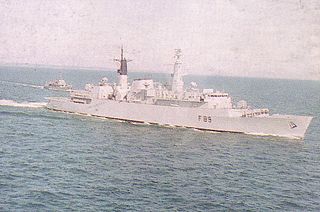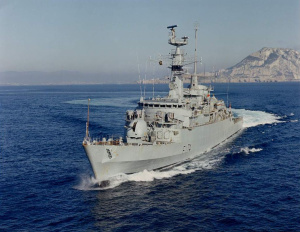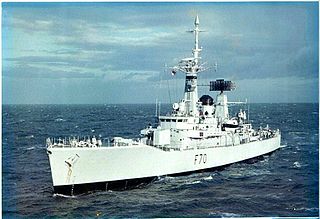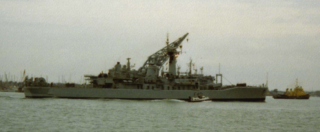
The Type 22 frigate also known as the Broadsword class was a class of frigates built for the British Royal Navy. Fourteen were built in total, with production divided into three batches.

HMS Battleaxe was a Type 22 frigate of the British Royal Navy. She was sold to the Brazilian Navy on 30 April 1997 and renamed Rademaker.

The Type 21 frigate, or Amazon-class frigate, was a British Royal Navy general-purpose escort that was designed in the late 1960s, built in the 1970s and served throughout the 1980s into the 1990s.

HMS Amazon was the first Type 21 frigate of the Royal Navy. Her keel was laid down at the Vosper Thornycroft shipyard in Southampton, England. The ship suffered a fire in the Far East in 1977, drawing attention to the risk of building warships with aluminium superstructure.

HMS Ambuscade was a Type 21 frigate of the Royal Navy. She was built by Yarrow Shipbuilders Ltd, Glasgow, Scotland. She entered service in 1975. Ambuscade took part in the Falklands War of 1982.

HMS Arrow was a Type 21 frigate of the Royal Navy.

HMS Alacrity was a Type 21 frigate of the Royal Navy.

HMS Avenger was a Type 21 frigate of the Royal Navy. Built by Yarrow Shipbuilders Ltd, Glasgow, Scotland, she was completed with Exocet launchers in 'B' position.

HMS Glamorgan was a County-class destroyer of the Royal Navy with a displacement of 5,440 tonnes. The ship was built by Vickers-Armstrongs in Newcastle Upon Tyne and named after the Welsh county of Glamorgan.

The Leander-class, or Type 12I (Improved) frigates, comprising twenty-six vessels, was among the most numerous and long-lived classes of frigate in the Royal Navy's modern history. The class was built in three batches between 1959 and 1973. It had an unusually high public profile, due to the popular BBC television drama series Warship. The Leander silhouette became synonymous with the Royal Navy through the 1960s until the 1980s.

HMS Andromeda was a Leander-class frigate of the Royal Navy. She was built at HM Dockyard Portsmouth. She was launched on 24 May 1967 and commissioned into the Royal Navy on 2 December 1968. She took part in the Falklands War. She was sold to India in 1995, for use as a training ship, being renamed INS Krishna. She was finally decommissioned in May 2012.
HMS Minerva (F45) was a Leander-class frigate of the Royal Navy. The ship commissioned in 1966 and took part in the Beira Patrol and Second Cod War during the 1970s and the Falklands War in 1982. Charles, Prince of Wales served aboard the ship in the 1970s. Between these major engagements, the frigate patrolled British territorial waters and took part in NATO and British military exercises. Minerva was decommissioned in 1992 and sold for scrap.

HMS Apollo was a batch 3B broadbeam Leander-class frigate of the Royal Navy. She was, like the rest of the class, named after a figure of mythology. Apollo was built by Yarrow Shipbuilders of Scotstoun. She was launched on 15 October 1970 and commissioned on 28 May 1972, making her the penultimate Leander.

HMS Sirius (F40) was a Leander-class frigate of the Royal Navy (RN) built by H.M. Dockyard Portsmouth, and was the penultimate RN warship to be built there for a period of forty years, until Vosper Thornycroft built HMS Clyde. Sirius was launched on 22 September 1964 and commissioned on 15 June 1966. The ship continued in front line service until February 1992.

HMS Danae was a Leander-class frigate of the Royal Navy. She was, like the rest of the class, named after a figure of mythology. Danae was built by Devonport Dockyard. She was launched on 31 October 1965 and commissioned on 10 October 1967.
PNS Shah Jahan of Shahjahan may refer to one of the following ships of the Pakistan Navy:

HMS Yarmouth was the first modified Type 12 frigate of the Rothesay class to enter service with the Royal Navy.

The Tariq-class destroyers were a class of guided missile destroyers of the Pakistan Navy. They were acquired from the British Royal Navy in 1993–94. The Tariqs were formerly commissioned in the Royal Navy's Surface Fleet as Type 21 (Amazon-class) frigates, a general purpose frigate in the Royal Navy.

PNS Tippu Sultan (DDG-185), a Tariq-class destroyer, served in the Pakistan Navy after it was acquired in 1994. Her design was based on the British Type 21 frigate, and previously served in the Royal Navy as HMS Avenger as a general purpose frigate.

PNS Shah Jahan (DDG-186) was a Tariq-class destroyer in service with the Pakistan Navy since being recommissioned in 1994. Based on the British design, Type 21 frigate, she previously served in the Royal Navy as HMS Active as a general purpose frigate.














